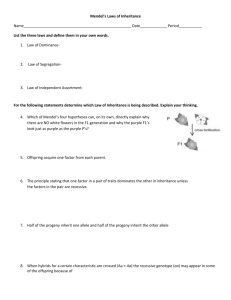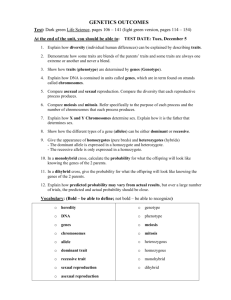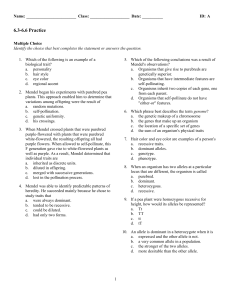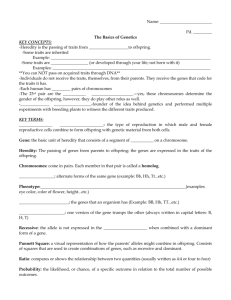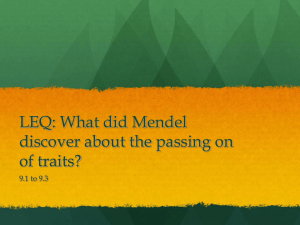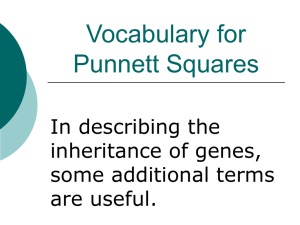S1-1-01 - Gregor Mendel - Powerpoint
advertisement
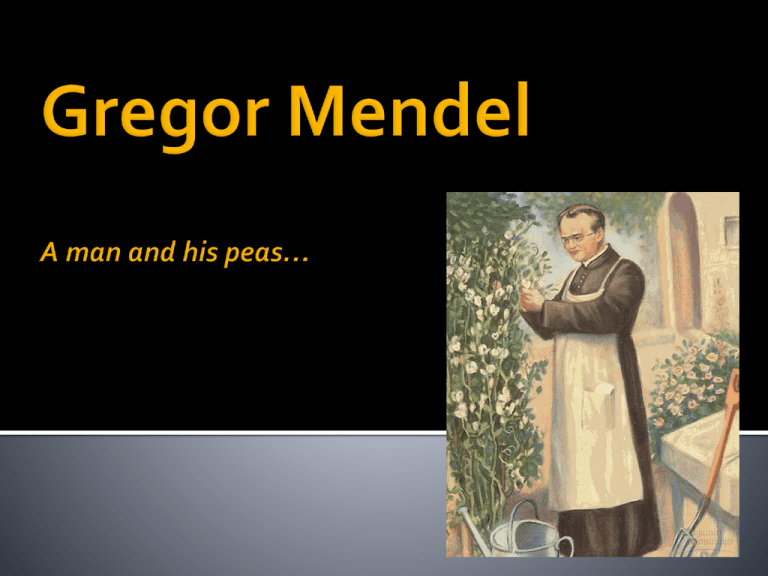
Aristotle thought that genes came from throughout the body to make up pangenes, called pangenesis Spermists believed the entire human was contained in the humunculus and that the uterus was used to incubate Ovists believed the entire human was contained in the egg and the sperm was used for its nutrients Homunculus Grew up in Austria in a poor farming family in the Czech Republic He wanted a better life for himself and thought the only way he could do so was by becoming a monk He left home in 1843, changing his name from Johann to Gregor The monastery decided to help him get an education by sending him to become a teacher …but he failed So later he was sent to a university in 1851 he studied under Christian Doppler, who taught him to learn science through experimentation He also had good math and plant science professors He decided to start studying genetics through peas at the monastery 1. 2. 3. Peas come in many different varieties- colours, shapes, sizes, etc. They have a short life span They are easy to grow Between 1856 and 1863, Mendel grew some 29,000 pea plants. http://tinyurl.com/MendelsPeas Mendel “cross-pollinated” the peas (artificial pollination) by using pollen from one plant to fertilize a different plant. Used TRUE-BREEDING PLANTS: all new plants have same traits as parent plants. (“breed true” = homozygous) Mendel used a few traits, and watched to see what happened when he crossed “parent plants” with opposite traits. (eg. Round x wrinkled pea) 1st generation: “Parents” (P1) 2nd generation: “First filial generation” (F1) 3rd generation: “Second filial generation” (F2) 4th generation: “Third filial generation” (F3) Filial means child or offspring in latin. For his experiments, Mendel crossed two true-breeding plants that had different traits for the same characteristic. Eg. He would cross a plant that was true-breeding for green pods with a plant that was true-breeding for yellow pods. When two true-breeding plants are crossed, this is called hybridization. The offspring from this cross are heterozygous, meaning they contain the two different genes for one trait. When he crossed wrinkled with round, the F1 were all round. He crossed the F1 plants, and some of the F2 were wrinkled, and some were round. He made hundreds more similar crosses, recorded the results, analyzed them mathematically, and came up with 4 principles of heredity. Mendel presented his work in a paper in 1865, “Experiments in Plant Hybridization” However, it was not well received and given little attention His work was significant not just because of his discoveries in genetics, but also because he used mathematical and statistical analysis to analyze his results. Soon after this he gave up science when he became the abbot of the monastery. He died in 1884. In 1900 three new scientists, Hugo DeVries, Erich Von Tschermak, and Carl Correns, who worked on genetics independent of one another finally gave Mendel the credit he deserved. 1. Genes In Pairs: Genetic characters are controlled by unit factors (genes) that exist in pairs in individual organisms and are passed from parents to their offspring. When two organisms produce offspring, each parent gives the offspring one of the factors from each pair. Mother contributes one allele and father contributes the other allele for a trait. An allele is the biological element located on a chromosome that carries the expression of a trait. We represent them with letters. One allele for hair colour from mom …and one from dad. 2. Dominance and Recessiveness: When two unlike factors responsible for a single character are present in a single individual, one factor can mask the expression of another factor. That is, one factor is dominant to the other, which is said to be recessive. Dominant alleles are represented with capital letters Dominant genes Recessive alleles are represented with small letters The baby is heterozygous for eye colour. She carries the dominant colour brown and recessive colour blue. Hetero means different. Bb bb BB The parents are both homozygous for eye colour. Homozygous means both alleles for a characteristic are the same. Homo means the same. Recessive genes bb Bb bb On this slide who is a heterozygote and who is a homozygote? 3. The Principle of Segregation: During the formation of gametes, the paired factors separate (segregate) randomly so that each gamete receives one factor or the other. Gamete: A cell containing half of the genes for their offspring. Eggs and sperm are gametes in humans. 4. Independent Assortment: During gamete formation, segregating pairs of different factors assort independently of each other. Blonde hair & blue eyes Brown hair and brown eyes Blonde hair from mother and brown eyes from father. Each characteristic is separate from another. Modern Recessive traits: •Many modern traits and disease are recessive •Cystic fibrosis, sickle cell anemia, albinism, Tay Sachs are all recessive autosomal diseases (genes are found on chromosomes other than the 23rd) Modern Mendelian Genetics: crossbreeding Belgian Blue Cattle


